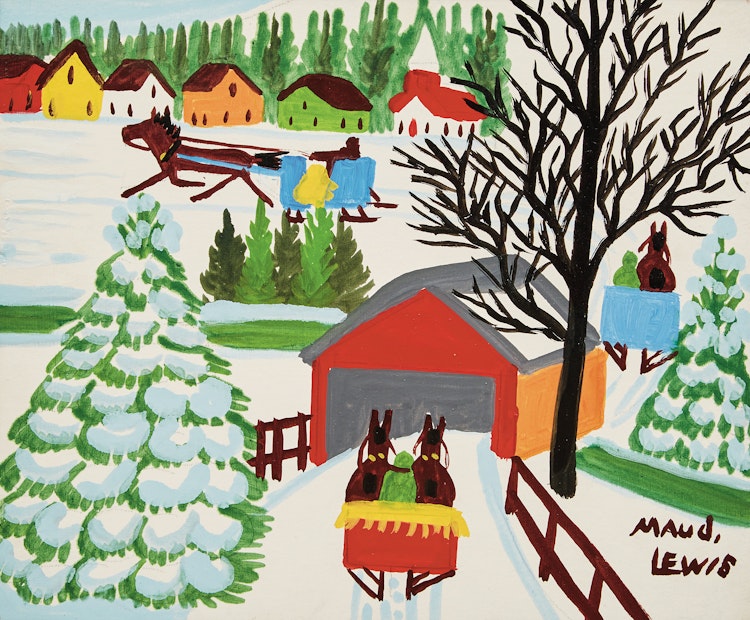Winter Sleighing Scene with a Covered Bridge by Maud Lewis

Maud Lewis
Winter Sleighing Scene with a Covered Bridge
mixed media on board
signed lower right
11.25 x 12 ins ( 28.6 x 30.5 cms )
Auction Estimate: $20,000.00 - $30,000.00
Price Realized $26,400.00
Sale date: December 1st 2022
Acquired directly from the Artist
By descent to the present Private Collection, Toronto
Lance Woolaver, “Maud Lewis: The Heart on the Door”, Halifax, 2016, page 205
Winter sleigh scenes are some of the most complex compositions produced by Maud Lewis. The layered fore, mid and background create depth and guide the eye through the scene. We follow the trail of sleighs as they wind along the road creating movement through the picture. The subject is a popular serial image. Lewis rarely left the confines of her small home and the repetition of the scenes suggests the repetition of the everyday hustle and bustle of life in Digby County. As Maud’s friend and neighbour, Flora Amero would recollect of the area, “it was a small world but a pretty place”.
Share this item with your friends
Maud Lewis
(1903 - 1970)
The simplicity of Maud Lewis' paintings, brushed initially with scrounged paint from local fishermen onto ubiquitous green boards and postcards, continue to evoke feelings of innocence, of child-like exuberance as enduring as the spring times she loved to paint. Her works continue to capture audiences intrigued by everyday scenes as diverse as hard-working oxen and whimsical butterflies.
Maud Dowley Lewis was born March 7, 1903 in South Ohio, a community near Yarmouth. Her father Jack would provide a moderately prosperous living as a respected craftsman, making harnesses and serving as a blacksmith. Agnes, her mother, favoured artistic pursuits including painting, folk carving and music. Maud led a confined but happy home life after she quit school at 14, perhaps in part to escape the mocking of her peers because of her physical difficulties. "What is life without love or friendship?"she once confided to a friend. The loss of both her parents within two years was tragic. Thankfully, an aunt who lived in Digby took her in. There she would later answer a newspaper ad that would determine the course of her life. A man named Everett Lewis wanted a housekeeper for his cottage in Marshalltown. She married him in 1938 at the age of thirty-four and would never travel more than an hour's drive from her birthplace. "I ain't much for traveling anyway," she said later, "as long as I have a brush in front of me, I' all right."
Although short in stature with hands stiffened by arthritis as the years passed, she stood tall when she plied her brush over green-backed particle board. Everett Lewis, a stingy, parsimonious but certainly hard-working man, kept house and made meals allowing Maud to spend most of her time delving into her world of wonder and creating fanciful works of art. Maud gathered images from her happy childhood and limited excursions in a Model T with Everett to paint cheerful images on dust pans, scallop shells and even on her house. They would settle into a routine where Everett enjoyed peddling and haggling over the paintings Maud would love to paint. The happiness she painted first attracted neighbours, then tourists and eventually even international attention. It started with a Star Weekly newspaper article and then a 1965 CBC Telescope program featuring her unique works. Her notoriety began to bloom like the cherry trees that garnished several of her paintings. Orders came in so fast that the paint hardly had time to dry--one reason you may notice fingerprints on some edges of her paintings.
Her style became as fanciful as her subjects. She painted a world often without shadows, autumn leaves on winter landscapes, and even three-legged oxen. Was she adding humour in her subtle, shy way? Her gentle nature and magnetic smile might give that away. Awkwardly bent over a painting, she may have been squinting and intense, but her inner joy escaped onto her panels with unrivaled determination and vitality. Small wonder her work garnered the attention of even the Nixon White House. Ever pragmatic, Maud wrote to ask that funds be forwarded before she sent the requested two panels to the President! Today her work unequivocally demands status as important art in numerous fine-art collections around the world.
Not formally trained, Maud adopted a style that emerged from inside the heart of a true artist. As such, she could produce images of enduring quality and appeal, images that transformed her maritime surroundings into painted visions. The irresistible charm of her art had triumphed over the arrows of adversity.
- Reproduced with permission from Wayne & Jocelyn Cameron

